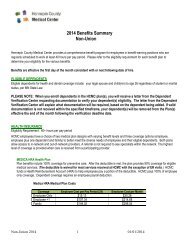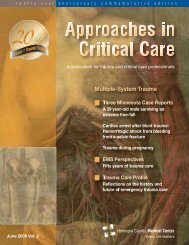Ischemic Stroke - Hennepin County Medical Center
Ischemic Stroke - Hennepin County Medical Center
Ischemic Stroke - Hennepin County Medical Center
You also want an ePaper? Increase the reach of your titles
YUMPU automatically turns print PDFs into web optimized ePapers that Google loves.
Case Reports<br />
The patient was awake, alert, oriented to person,<br />
place, and time, maintaining her airway,<br />
and breathing spontaneously. She had 2+ distal<br />
pulses. She was moving her right arm and<br />
both legs, but her left arm was held at her<br />
side. The patient had 5/5 strength in all<br />
extremities except her left upper; she was<br />
unable to lift her arm off the cart, was not able<br />
to grip, and was not able to perceive touch.<br />
The remaining physical exam was normal.<br />
Figure One. CT scan<br />
obtained on presentation to<br />
the Emergency Department.<br />
Figure Two. CT scan<br />
obtained after placing<br />
ventriculostomy on hospital<br />
day 3.<br />
Figure Three. CT scan<br />
obtained the day prior<br />
to discharge after 39<br />
days in the hospital.<br />
The patient was given one liter of normal<br />
saline and Dilaudid for pain. A computed tomograph<br />
(CT) scan of her head without contrast<br />
was obtained. (See Figure One.) The images<br />
revealed a well-established hypodensity in the<br />
distribution of the right middle cerebral artery.<br />
Also noted was a significant associated<br />
edema-induced mass effect and approximately<br />
6-7 mm of right-to-left midline shift and mild<br />
sub-falcine and uncal herniation. Immediately<br />
following the patient's return from radiology,<br />
she was started on Dilantin for seizure prophylaxis;<br />
5% hypertonic saline was started to prevent<br />
further midline shift.<br />
The decision was made not to treat with<br />
thrombolytics and to treat the edema conservatively<br />
in the Surgical Intensive Care Unit<br />
(SICU). The patient was closely followed by<br />
the neurocritical care and neurosurgery team<br />
members. Serial CT scans revealed an evolving<br />
hypodensity with extensive edema. (See<br />
Figure Two.) Concerns about increased ICP<br />
prompted the placement of a ventriculostomy.<br />
The initial ICP was 20 mmHg. Blood pressure<br />
was controlled with a mean arterial pressure<br />
(MAP) >70 mmHg and systolic blood pressure<br />
(sBP) 320 osmols. She was placed<br />
on deep venous thrombosis prophylaxis<br />
with heparin.<br />
Over the next several days in the SICU,<br />
repeated attempts at clamping the ventriculostomy<br />
were poorly tolerated by the patient;<br />
when this was attempted, changes were noted<br />
in her mental status and her ICP increased to<br />
25-40 mmHg. Mechanical drainage of CSF<br />
(averaging 200cc per day) would return the<br />
ICP to less than 10 mmHg. During the period<br />
of peak ICP measurements on days three<br />
through nine, a combination of 3% hypertonic<br />
saline and CSF drainage was used, with the<br />
goals of maintaining ICP 60 mmHg, and<br />
sodium
















